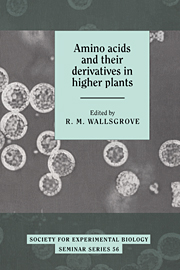Book contents
- Frontmatter
- Contents
- List of contributors
- Preface
- Glutamine synthetase in higher plants: molecular biology meets plant physiology
- Interactions of nitrogen and carbon metabolism: implications of PEP carboxylase and isocitrate dehydrogenase
- The genetics of aspartate derived amino acids in higher plants
- Oxidation of 1-aminocyclopropane-1-carboxylic acid (ACC) in the generation of ethylene by plants
- Regulation of carbon flow through the branched chain amino acid biosynthetic pathway
- Amino acid metabolism and protein deposition in the endosperm of wheat: synthesis of proline via ornithine
- The glycine decarboxylase complex in higher plant mitochondria: structure, function and biogenesis
- Glycine and serine synthesis in non-photosynthetic tissues
- Biogenesis of N-heterocydic amino acids by plants: mechanisms of biological significance
- Toxicity of non-protein amino acids from plants
- Processes involved in glutathione metabolism
- Betaines in higher plants – biosynthesis and role in stress metabolism
- Metabolism and function of polyamines during osmotically induced senescence in oat leaves and protoplasts
- Biosynthesis of cyanogenic glucosides. Elucidation of the pathway and characterization of the cytochromes P-450 involved
- The biosynthesis of glucosinolates in Brassicas
- Biochemical genetics of aliphatic glucosinolates in Brassica and Arabidopsis
- Index
Oxidation of 1-aminocyclopropane-1-carboxylic acid (ACC) in the generation of ethylene by plants
Published online by Cambridge University Press: 09 April 2010
- Frontmatter
- Contents
- List of contributors
- Preface
- Glutamine synthetase in higher plants: molecular biology meets plant physiology
- Interactions of nitrogen and carbon metabolism: implications of PEP carboxylase and isocitrate dehydrogenase
- The genetics of aspartate derived amino acids in higher plants
- Oxidation of 1-aminocyclopropane-1-carboxylic acid (ACC) in the generation of ethylene by plants
- Regulation of carbon flow through the branched chain amino acid biosynthetic pathway
- Amino acid metabolism and protein deposition in the endosperm of wheat: synthesis of proline via ornithine
- The glycine decarboxylase complex in higher plant mitochondria: structure, function and biogenesis
- Glycine and serine synthesis in non-photosynthetic tissues
- Biogenesis of N-heterocydic amino acids by plants: mechanisms of biological significance
- Toxicity of non-protein amino acids from plants
- Processes involved in glutathione metabolism
- Betaines in higher plants – biosynthesis and role in stress metabolism
- Metabolism and function of polyamines during osmotically induced senescence in oat leaves and protoplasts
- Biosynthesis of cyanogenic glucosides. Elucidation of the pathway and characterization of the cytochromes P-450 involved
- The biosynthesis of glucosinolates in Brassicas
- Biochemical genetics of aliphatic glucosinolates in Brassica and Arabidopsis
- Index
Summary
Introduction
Ethylene is the plant growth regulator that controls ripening and senescence in plants. It is produced from methionine via the formation of S-adenosyl-l-methionine, which, in turn, forms the non-protein amino acid, 1-aminocyclopropane-1-carboxylic acid (ACC) (Fig. 1). When ACC was first recognized as the immediate substrate for ethylene formation, it became apparent that all kinds of plant tissues had an active and constitutive enzyme capable of catalysing the conversion of ACC to ethylene, as high rates of ethylene production were observed when plant tissues were supplied with ACC (Cameron et al., 1979). The rate of ethylene production when tissues were fed ACC was always far greater than when they were fed methionine under the same conditions (Yang & Hoffman, 1984). During climacteric fruit ripening and flower senescence an initially low ACC oxidase activity increased in line with the rise of ACC synthesis and ethylene production (Yang & Hoffman, 1984). However, despite the substantial ACC oxidase activity that was readily observed with plant tissues, in vitro activity could not be detected. When tissues were homogenized, methionine was readily converted enzymatically to ACC, but there was no ethylene formation, and ACC supplied to tissue homogenates was not converted to ethylene. These observations led to the notion that ethylene formation required membrane integrity (Yang & Hoffman, 1984). This view was supported by the sensitivity of ACC oxidase to osmotic shock, detergents and protonophores, and by the discontinuities in the Arrhenius plots for ethylene production (see Yang & Hoffman, 1984; Kende, 1993).
- Type
- Chapter
- Information
- Amino Acids and their Derivatives in Higher Plants , pp. 51 - 58Publisher: Cambridge University PressPrint publication year: 1995
- 2
- Cited by



